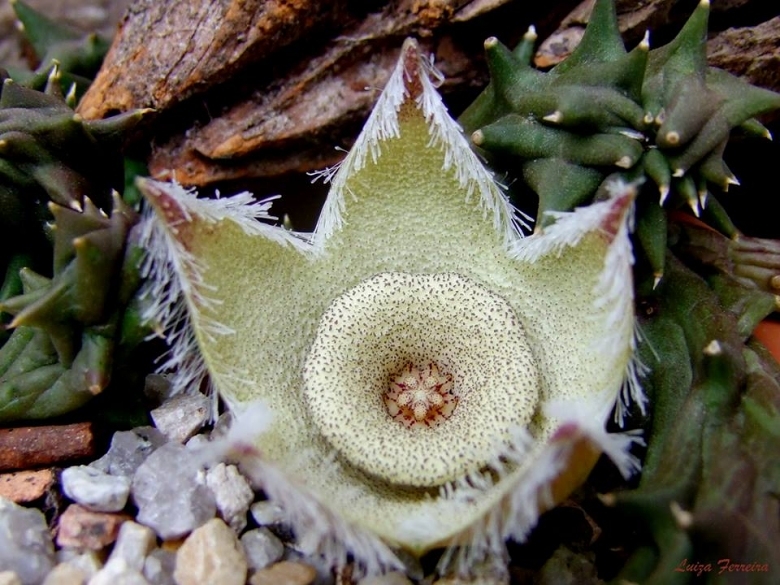Accepted Scientific Name: Orbea ciliata (Thunb.) L.C.Leach
Kirkia 10(1): 291 1975

Stapelia ciliata (Orbea ciliata) Photo by: Luiza Ferreira
Origin and Habitat: It is native to the Karroo Desert in South Africa. (Calvinia Div; Hantam, Ceres Div.; Karoo between the Roggeveld Mountains and Paarde Berg; Karoo between Bokkeveld and Paarde Berg; Beaufort West Div.; Nieuwveld, between Rhenoster Kop and Ganzefontein; Prince Albert Div.; Karoo near Prince Albert)
Synonyms:
See all synonyms of Orbea ciliata
back
Accepted name in llifle Database:Orbea ciliata (Thunb.) L.C.LeachKirkia 10(1): 291 1975Synonymy: 9
back
Common Names include:
ENGLISH: Starfish Stapelia, Near-white Starfish, Double Crown, Double Cup
Description: Orbea ciliataSN|23062]]SN|23062]] is one of the oldest known “stapelia” easily recogizable for the creamy-white flowers with a prominent fleshy cup or raised annulus which forms part of the corolla and for the clavate and strongly vibratile hairs which form a fringe along the edge of the corolla lobes. These hairs hardly remain still and move in the slightest breeze, possibly attracting insects. It is a prostrate-growing plant with branches rooting at the base,
Stems: Short, decumbent and ascending, and branching from the base 4-7 cm long, 12-18 mm thick, exclusive of the teeth, obtusely 4-angled, glabrous, greyish-green, mottled with purple; Teeth conical acute, divergent, 4-8 mm long. In cultivation stem tips often become funnel-shaped (cristate) with cup-shaped depressions. In a good light the stems become attractively dark purple-brown.
Flowers: Sub-solitary, up to about 7-10 cm across, bowl-shaped from near the base or middle of the stems with hardly any trace of the carrion odour characteristic of stapeliads. Pedicels 10-12 mm long, erect, glabrous. Sepals about 6-8 mm long 2-4 mm wide, convex ovate or ovate-lanceolate, acute, glabrous. Corolla about 7,5 cm in diameter, pale-green stripped with reddish, smooth and glabrous outside, densely papillate-rugose on the innerface, greyish to pale yellowish, minutely dotted with red, raised at the mouth around the thick recurved rim of the inner tube, which is densely covered with stiff purple hairs at the base around and under the corona. Corolla lobes about 2,5 cm long, 2 sm broad, spreading, ovate, acute, more or less revolute, ciliate from base to apex with clavate strongly vibratile white hairs. Outer corona-lobes arising above the base of the staminal column, connate at the base, somewhat spreading, with the free part 2 mm long, transverse or subquadrate, very obtusely or subacutely bifid, glabrous, apparently yellowish dotted with purple-brown. Inner corona-lobes lying against the backs of the anthers, about 1,5 mm long, thick, ovate, acute, or acuminate with the tips produced into a very short erect point, apparently yellowish, dotted and marked with purple-brown without extended horns or wings.
Subspecies, varieties, forms and cultivars of plants belonging to the Orbea ciliata group
 Orbea ciliata (Thunb.) L.C.Leach: has creamy-white flowers with a raised annulusand strongly vibratile hairs which form a fringe along the edge of the corolla lobes. These hairs hardly remain still and move in the slightest breeze.
Orbea ciliata (Thunb.) L.C.Leach: has creamy-white flowers with a raised annulusand strongly vibratile hairs which form a fringe along the edge of the corolla lobes. These hairs hardly remain still and move in the slightest breeze. Orbea ciliata var. cristata (P.V.Heath): This is the most common form in cultivation with stem tips often funnel-shaped (cristate) with cup-shaped depressions.
Orbea ciliata var. cristata (P.V.Heath): This is the most common form in cultivation with stem tips often funnel-shaped (cristate) with cup-shaped depressions.
Bibliography: Major references and further lectures
1) N. E. Bbrown. "Flora Capensis", Vol 4, page 518 (1909)
 Stapelia ciliata (Orbea ciliata) Photo by: Luiza Ferreira
Stapelia ciliata (Orbea ciliata) Photo by: Luiza FerreiraSend a photo of this plant.The gallery now contains thousands of pictures, however it is possible to do even more. We are, of course, seeking photos of species not yet shown in the gallery but not only that, we are also looking for better pictures than those already present.
Read More... Cultivation and Propagation: Orbea ciliataSN|23062]]SN|23062]] is one of the easiest stapeliads to grow. It like a half-sun or shaded position (never grow in too harsh sun), very resistant to heat will also tolerate quite cold temperatures but avoid frost, best in a ventilated environment. It is quite resistant to the “Balck spot” disease of Asclepiads, Water regularly during the growing season, keep dry in winter. Use a gritty, well-drained soil.
Propagation: It is easily propagated by removing a cutting, sometimes with roots attached, in spring and summer, but seeds germinate readily if they are sown when fresh.











